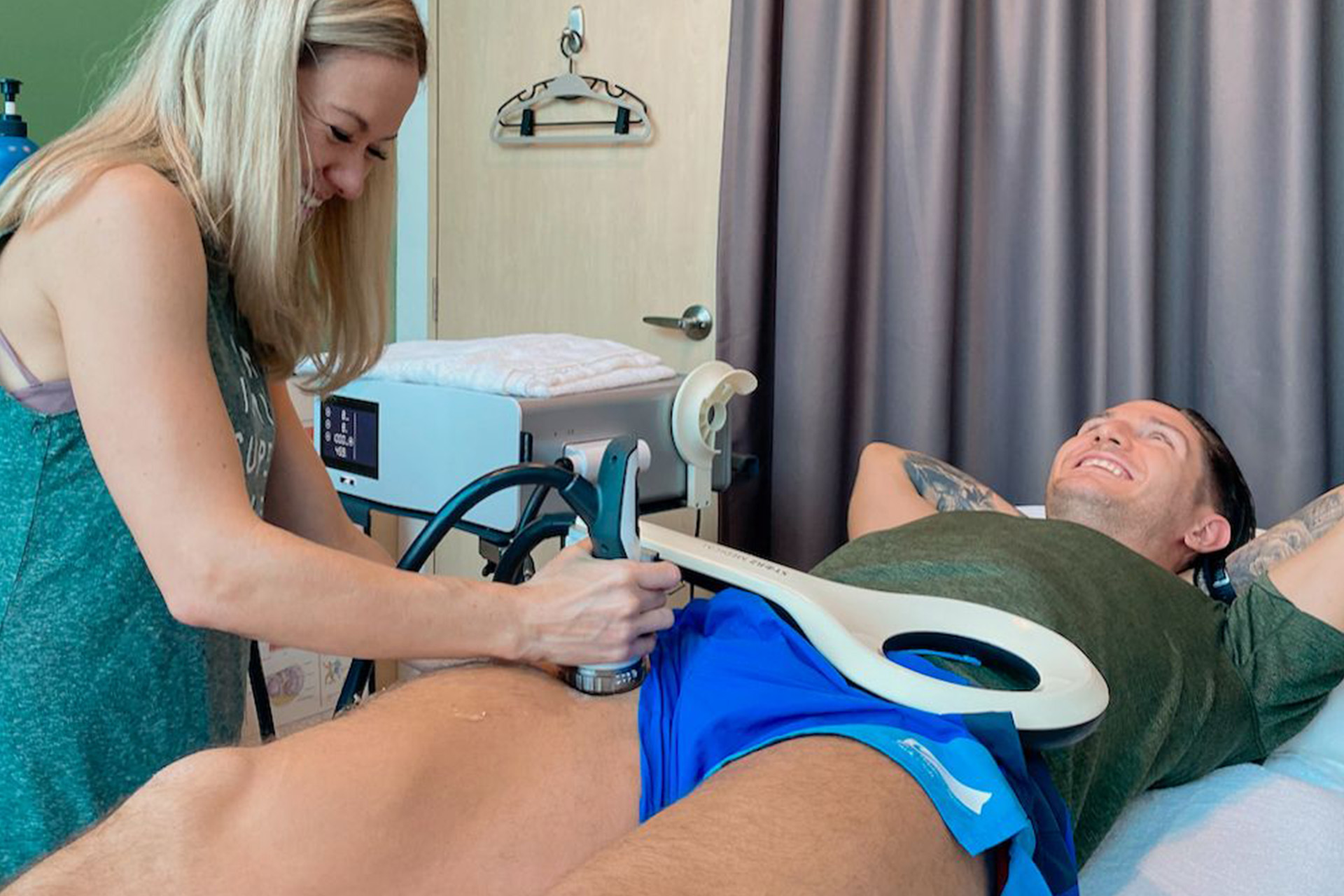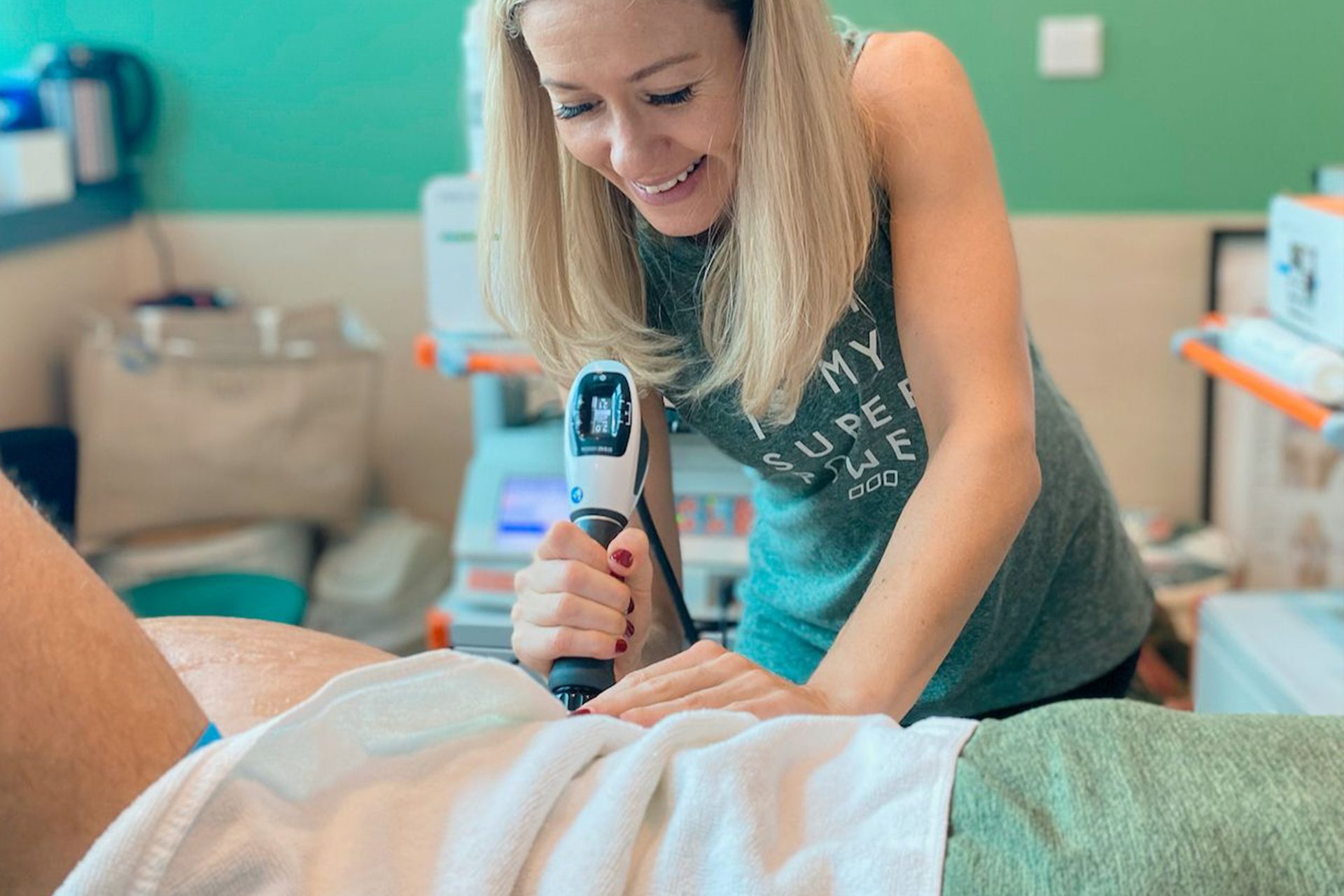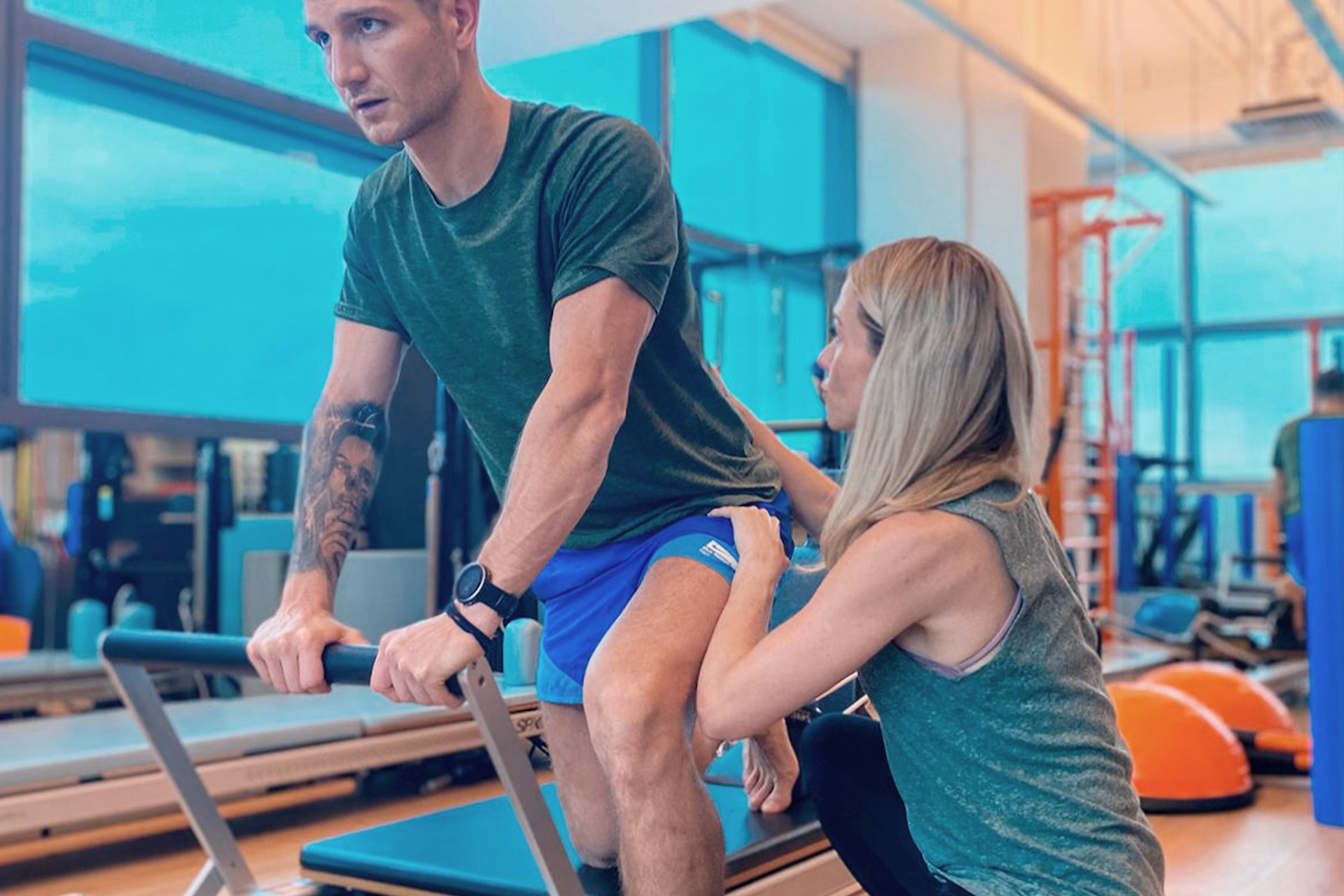Musculoskeletal Disorders
Hip Pain Causes and Physiotherapy Treatments
Physiotherapy for Hip Pain
Physiotherapy is vital to relieve hip joint pain, promote healing and strengthen the hip muscles surrounding the joint. It’s a critical therapy to ease discomfort, especially after invasive total hip replacement surgery, as part of your recovery .
Jump to section on ...
After hip replacement surgery, you will initially find difficulty standing and walking without assistance, which can add to a host of secondary issues from muscle atrophy or scar tissue calcification around the hip joint, leading to decreased range of movement. Without the proper treatment, a reduced range of motion can lead to future injuries years later.
That’s where hip physiotherapy at HelloPhysio can benefit that healing process, using leading technologies combined with traditional physiotherapy to quickly restore mobility to your hips and build the strength of muscles and tendons to prevent future injury.
Leading hip pain physiotherapy treatment at our private clinic in Singapore may include:
- Manual therapy and Clinical Pilates to readjust movement patterns to regain strength and mobility.
- INDIBA thermal cellular therapy to aid in soft and hard tissue rehabilitation.
- Shockwave Therapy breaks up scar tissue in the hip joint and muscle groups by promoting blood circulation.
- Electromagnetic Transduction Therapy to improve fibroblast and collagen proliferation to reduce inflammation.
HelloPhysio brings the latest evidence-based treatments and adjunctive technologies to improve patient outcomes for musculoskeletal disorders. Whether you’re suffering from chronic pain, arthritic hip, degenerative hip condition, or require physiotherapy post-hip replacement surgery, our team is here to help get you back to a full, active lifestyle.

Common Conditions Causing Hip Pain
Hip pain can stem from a variety of problems. It can start as stiffness or tightness in the hip area and develop into pain and more severe discomfort. Arthritis, a sprain, or sciatica can cause hip pain, but often it results from osteoarthritis. A herniated disc or strained muscle could also cause pain in the hip with the intensity of the pain varying from mild to severe.
The specific location of the pain can tell your physiotherapist a lot about what condition you may be afflicted with. It could be one of the many injuries listed below or can sometimes stem from lower back injuries, which means your back needs to be strengthened rather than your hip. It is vital to speak with your physiotherapist rather than self-diagnose so that your injury can be treated accurately and effectively. Having said that, hhere are some common causes of hip pain:
- Arthritis can cause pain and discomfort to your joints. A physiotherapist can help you improve your posture and movement techniques so you don’t injure or damage your joints long-term. They can also help relieve some of your rheumatoid arthritic pain.
- Femoroacetabular Impingement or Hip Impingement is when the ball of the hip pinches up against the cup. Over time, this can cause damage to the cartilage in the area, creating stiffness and pain in the hip area. Your hip pain physio can provide you with modifications to your regular activities and other physical therapy techniques to help ease the pain and prevent arthritis.
- Hip Bursitis is a condition that can occur when a small sac of fluid located between the bone and soft tissue, known as the “bursa,” becomes inflamed. Bursitis often results from overuse or repetitive injuries and can affect many body areas, such as the hips and knees. Recovery and relief from pain are possible with treatments.
- Hip Fractures usually occur after a fall for the elderly or younger people, after a high-impact injury like a car accident. A hip fracture is when the femur connecting to the hip socket breaks. It can lead to lower back pain, knee pain, and possibly the inability to stand or walk. Hip fractures typically require surgery. Your physio can ease you with the rehabilitation process post-surgery, restoring your strength and providing relief from pain.
- Hip Injury can be caused by several things, including a fall, a direct blow, a twist, or excessive muscle contraction. The goal of physiotherapy is to unload the injured tissue and focus on improving neuromuscular control around the hip joint.
- Hip Labral Tears occur when the cartilage that connects the femur to the socket of your pelvis is damaged. The cartilage is vital to maintain frictionless motion in the hip. With a hip labral tear, there can be pain in the hip or groin areas, sometimes while active, and other times during rest.
- Hip Osteoarthritis is a type of arthritis that typically comes with age, though some people can be genetically predisposed. Specifically, it comes from the wear and tear in the joints, which worsens and requires treatment to prevent the condition from becoming debilitating.
- Hip Replacement and Total Hip Arthroplasty should be the last recourse after exploring nonsurgical treatments. Artificial implants replace the ball and socket of the hip joint to ease pain and restore function. Physiotherapy will be an integral part of your rehabilitation post-surgery.
- Iliotibial Band Syndrome, like many other injuries, is often caused by repetitive motions and overuse, like running, cycling, or excessive walking. The Iliotibial Band is a tendon in your upper leg. After overuse, the tendon can become swollen, rubbing against bones and causing knee and hip pain. Consulting with a hip pain physio will help lessen your pain, restore movement and help you become pain-free.
- Tendinitis affects the tendons, causing pain near the joints. It can afflict any of your tendons, but it frequently occurs in areas of overuse, like tennis elbow or Achilles tendinitis. Physical therapy can help with hip tendonitis by stretching and strengthening the hip area.
Speaking with our physiotherapist team for accurate and effective treatment rather than self-diagnosing is a vital step to protect your overall musculoskeletal health today and in the future.
Hip Joint Pain in Aging Populations
Hip joint pain is a common concern, particularly among older individuals. As we age, addressing this discomfort is crucial to maintaining a good quality of life. The leading causes of hip joint pain in aging populations are osteoarthritis and rheumatoid arthritis. Osteoarthritis occurs as the protective cartilage in the hip joint gradually wears down over time, resulting in pain and stiffness. In contrast, rheumatoid arthritis is an autoimmune disorder affecting multiple joints, leading to inflammation, pain, and potential joint damage.
Typical symptoms include pain in the hip joint, groin, or thigh, stiffness, and limited range of motion. Pain often worsens with movement, making walking, climbing stairs, or prolonged standing challenging. Additional signs may include swelling and tenderness around the hip area and aching or discomfort extending to the buttocks or knee.
Typically, conservative treatments such as physical therapy for hip pain are used as a pain management technique before considering more invasive options like surgery.
Hip Pain Physiotherapy Treatments
There are many different physiotherapy treatments for hip pain. These include Clinical Pilates, Shockwave Therapy, and, in some cases, MAGNETOLITH® Extracorporeal Magnetotransduction Therapy (EMTT) to treat degenerative hip joint diseases. These will help you recover faster from operations, where applicable, and prevent future injury.
In Shockwave Therapy, your physiotherapist will apply precise radial shockwaves to afflicted areas, such as your hip, to help manage discomfort, reduce pain, and stimulate healing. The shockwaves also can make rehabilitative exercises easier by mitigating the pain.
EMTT, like Shockwave Therapy, uses the latest technology to help with your pain. Magnetolith EMTT uses magnetic waves by penetrating the afflicted area with a high oscillation frequency. Unlike Shockwave Therapy, Magnetolith EMTT is used on a region of the body rather than a precise point. This can help with overall rehabilitation, stimulating healing and growth.
Physiotherapy following hip surgery works to restore mobility and build strength. Physiotherapy can also be helpful for pre-operation, improving quality of life, and reducing pain for patients awaiting surgery. Exercises and stretches are commonly used in physiotherapy to help improve strength mobility and relieve pain. For example, hamstring and iliotibial band stretches can help relieve stiffness in the muscles around the hip.
Measures to Significantly Reduce the Risk of Developing Hip Joint Issues
A combination of physiotherapy for hip joint pain strategies can be employed in addition to the general recommendations to avoid pain in adult populations. Proper footwear is crucial, as supportive and well-fitting shoes can maintain proper alignment and reduce hip stress. Incorporating hip-strengthening exercises into your fitness routine, such as leg lifts, hip bridges and stretches, can help improve hip joint stability and flexibility.
Balanced muscle development around the hips is essential, emphasizing both the inner and outer hip muscles to prevent imbalances that could contribute to joint issues. Before physical activities, warming up and including hip-focused stretching exercises can enhance hip joint mobility and reduce the risk of discomfort. Opting for joint-friendly activities like swimming or cycling over high-impact sports can also be beneficial in preserving hip health.
Proper hydration is key for joint lubrication, and consulting with a healthcare provider about supplements like glucosamine and chondroitin may offer joint support. Ergonomics in your workspace and daily activities should be optimized to minimize hip strain, particularly if you have a desk job. Engaging in practices like Pilates and yoga can also improve flexibility, balance, and core strength, indirectly benefiting hip joint health.
Managing stress levels through meditation and relaxation exercises may reduce muscle tension and discomfort in the hips. Additionally, biomechanical assessments performed by a physical therapist or orthopedic specialist can identify any gait or alignment issues contributing to hip pain. Limiting prolonged sitting and taking breaks to stand and stretch can mitigate hip stiffness. Lastly, exercising caution in potentially hazardous situations to prevent falls or trauma that can lead to hip injuries is vital.
By adopting a multifaceted approach, individuals can take proactive steps to reduce the risk of hip joint pain and maintain mobility as they age.
Appointments for Hip Pain Physiotherapy in Singapore
HelloPhysio combines therapies from our multidisciplinary team of experts specializing in diagnosing and treating hip, joint, and muscle problems in adults and younger populations.
Empowering patients to actively engage with their physiotherapist, ask questions, and participate in treatment decisions is essential for effective management. Timely intervention and personalized treatment plans can improve overall musculoskeletal health and quality of life, ensuring a comfortable and active aging experience. No matter your situation, HelloPhysio has a treatment plan to return you to full mobility.


